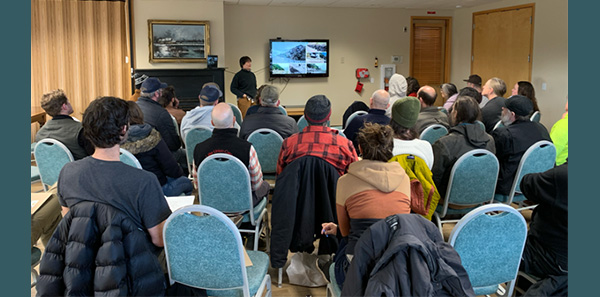Tuesday, November 2 @ 5 p.m. on Zoom
||| FROM KRISTA BOUCHEY for ORCAS POWER & LIGHT CO-OPERATIVE |||
CLARIFICATION: The energy roundtable is simply a forum for members to discuss the proposal – but staff will not be presenting information – it’s up to the members to come to the roundtable informed. The materials are posted online and links have been provided in the comments on the article.
Whether or not you’re interested in solar, this proposal affects your power bill. OPALCO is proposing a change to the rate structure for members who generate power (mostly solar) on the co-op grid: specifically, the rate that they are paid for their excess production. OPALCO continues to support local
solar production and must also safeguard the future affordability of power for all members. The problem isn’t solar production, it’s the trend of subsidies that are growing larger with more solar producers on the system.
Since 2008, OPALCO members have subsidized the amount that solar producers pay for the use of the grid that they use to buy electricity (like everyone else), and also to sell the surplus energy they produce. This year, OPALCO members will collectively pay about $300,000 to subsidize about 400 solar producers, and that subsidy is growing as more members add rooftop solar. We forecast that the subsidy will grow to about $2 million in the next eight years.
Solar producers are subsidized by the rest of the membership because the majority of the Co-op’s fixed costs (non-energy expenses) are collected through kWh charges for energy usage and solar producers buy less energy when they are producing. As more members install solar on OPALCO’s system, the gap in revenue collection affects the financial viability of the Co-op while increasing the burden on the rest of the membership.
The proposed solar rate offers a credit for the local energy benefits that solar producers bring to the Co-op, and it improves fairness and Co-op financial sustainability by reducing the gap between paying their full share of grid costs and the current subsidized rate. This rate adjustment is only the first step in
making sure all members are paying their fair share for energy.
Read more about solar rates and consider joining us for a (virtual) Energy Roundtable on November 2 at 5 p.m. via Zoom. Contact us by November 2 at 3 p.m. to get the link: communications@opalco.com. Can’t attend? We still want to hear from you! Review the materials and drop us a line at communications@opalco.com.
Orcas Power &Light Cooperative (OPALCO) is our member-owned cooperative electric utility, serving more than 11,400 members on 20 islands in San Juan County. OPALCO provides electricity that is 97% greenhouse-gas free and is generated predominantly by hydroelectric plants. OPALCO was founded in
1937.
**If you are reading theOrcasonian for free, thank your fellow islanders. If you would like to support theOrcasonian CLICK HERE to set your modestly-priced, voluntary subscription. Otherwise, no worries; we’re happy to share with you.**









Here is the link for the materials referenced above: https://www.opalco.com/quick-fact-understanding-the-change-in-solar-rates/2021/10/
I thought fixed costs were collected from the service access charge not from the kWh energy charges. At least that was the reason given when the service access charge was increasing every year until we got to the over $48.00 we’re at now. It was less than $28.00, I believe, before the year after year increases started.
This is Suzanne Olson from OPALCO’s communications team.
First of all, to clarify: the Energy Roundtable is an opportunity for members to discuss the solar rates proposal, which is explained in materials posted online and sent via the OPALCO email newsletter: https://www.opalco.com/quick-fact-understanding-the-change-in-solar-rates/2021/10/. The proposal itself, tariffs and policies are all posted for public review in the October board materials: https://www.opalco.com/wp-content/uploads/2021/10/October-2021-Board-Materials-reduced-2.pdf. OPALCO staff will not be presenting information at this meeting, simply listening and collecting member feedback on the proposal.
Second, to respond to Darlene’s question about the service access charge – check out the quick fact (link above) for more information (and a chart) on the history of the service access charge vs fixed costs. OPALCO has been slowly shifting the balance of how non-energy expenses (fixed costs) are collected over the years to avoid rate shock – but, as of today, the service access charge we pay ($48.41) collects only about 50% of fixed costs. It’s an issue OPALCO will continue to address in future rate discussions. The solar rate change is also a progressive shift towards a more equitable balance over time; the proposal for 2022 is one small step.
Please read the proposal and join us on November 2nd to share your thoughts, or send us your comments at communications@opalco.com.
No to a Solar Production Tax!
As one of the 400 solar producers I’m not sure why the “subsidy” is being presented this way.
What is left out of the proposal is that there is no subsidy. The COOP buys my solar at the same rate I buy the COOP (our) power.
This change means that I would have to pay $.02476 /kw to “sell ” my power. Isn’t that a tax?
The web page graph projecting exponential “subsidy ” cost increase over time is also misleading . There is no allowance for the relative cost increase of Bonnyville energy; where local production can be arbitrarily valued.
I can make the same case that all those great heat-pump water heaters and mini splits the coop has subsidized (which I fully support) has also reduced the KW energy use of each house. That’s the point! Should their power rate be increased to compensate?
I remember that warm winter the COOP was all concerned because ‘the less we used the more we would pay’. Real double speak
How can we conserve energy when the rate structure has a perverse incentive not to?
Are the millions invested in upgrades associated with the fiber what is not covered in the Service Access Fee?
In the 4 months of summer I actually generate more power than I use and I get a Credit in the bank. October Bill shows for first 9 months of 2021 I have used 11,131kw ‘from grid’ and generated ‘6,334’ to grid. paying for 4,797.KW net used. So on paper I could also be a small cabin that used 479kw each month so far this year.
Or, under the new proposal, I am now an energy conserving member that is charged 20% more per KWhr for my climate investment.
Under this plan if I reduced my usage to equal my generation, the Net Zero goal, I can expect a $156 bill beyond the $484 Service Access Fees for these 10 months.
This is seriously backwards.
Will the Decatur project be charged this generation tax? If so I might want my donation back.
Guliver, excellent points. It’s getting harder and harder to feel we have transparency when the discussion starts with questionable information.
Dependability from the Co-op inverters (the Us’s ) are feeling isolated from the direction of commerce..
The question arises, are we for profit, or elevated infer structure or sustainability…
Costs are just that , Costs… but the track record has ruts.
I am curious how the pay range for the director of Opalco is being considered in this discussion. Seems like the rate and then the Rock Island pay and the bonuses are quite remarkable. Maybe we need to look at the total HR budget and reconsider where reductions need to be made. Solar production seems to be a benefit for the community and should be valued as such.
I agree that the rate structure should reward energy conservation and rooftop solar energy production.
Let’s see a chart of the HR costs alongside the provided chart of the “solar subsidy” , same time frame. Setting the director’s compensation at a more reasonable rate and reigning in a few HR expenses would I believe more than make up for the “solar subsidy” costs. Let’s not penalize the solar generators for doing the right thing and instead find other ways to cut expenses.
Nearly a decade ago, the Arizona Corporation Commission imposed an grid access charge for solar customers, after Arizona Public Service stated that it cost more money to serve solar customers. SEIA testified and was able to prove that solar customers in Arizona pay their fair share of grid costs and do not introduce additional costs to other customers.
A grid access charge that had been in place for nearly a decade for Arizona Public Service’s solar customers is no more. State regulators have chosen to eliminate the fee.
The fee amounted to roughly $100 per year per solar customer It was instituted under the premise that it costs the utility more to provide solar customers with electricity service. The decision to remove the charge is, in large part, due to the efforts of the Solar Energy Industries Association (SEIA). The organization testified against the charges in October 2020 and December 2020 and showed that solar customers paid their fair share of grid costs compared to non-solar customers.
In addition, SEIA showed the Arizona Corporation Commission (ACC) that the utility’s claims about increased service costs for solar customers were unsubstantiated.
https://www.seia.org/news/seia-axes-grid-access-charge-arizona
And…
From SEIA–https://www.seia.org/initiatives/principles-evolution-net-energy-metering-and-rate-design
Some Guiding Principles for Solar Rate Design
• Rate design should seek to send clear price signals to customers that encourage sustainable, cost-effective investments in solar and complementary technologies.
• Rate designs should not create barriers to the deployment of distributed solar generation or DER technologies other than solar.
• Rate designs that emphasize higher fixed (e.g. customer, service and facility or basic service) charges than necessary for recovery of strictly customer-related costs like service drop, billing, and metering, or quasi-fixed (e.g. mandatory residential demand) charges do not reflect cost causation, disproportionately impact low and moderate income customers, and should be discouraged.
• Regulatory review of rate design alternatives should consider impacts on low-income customers; e.g. utility fixed or quasi-fixed charge proposals usually put solar and efficiency technologies further out of reach of LMI customers.
OPALCO needs to be forward-thinking. That means it must consider the coming climate changes and its implications for the San Juan Islands. OPALCO will do better if it begins and encourages member investment in technologies that strengthen our local grid by providing resiliency. Some starting places are listed below.
Government Example:
NODES–ARPA–E
The infrastructure that defines the U.S. electric grid is based largely on pre-digital technologies developed in the first part of the 20th century. In subsequent decades, grid development has evolved through emphasis on safety, accessibility, and reliability to security and resiliency. Throughout this evolution, the grid mainly relied on centralized power plants and developed protocols to provide system reliability based on that model. However, currently the increasing use of renewable generation DERs, such as residential solar and home energy storage, along with customers’ changing energy use patterns are leading to greater uncertainty and variability in the electric grid. The next generation grid requires real-time adaptation by advanced management and control methods and architectures to enable a new interconnected power system, with a high level of renewable generation and a large number of DERs, while maintaining the quality of service, resiliency, and reliability that customers expect.
https://arpa-e.energy.gov/technologies/programs/nodes
Commercial Examples:
1) Electric utility Rocky Mountain Power (RMP) is incentivizing more than 50,000 residential and commercial solar power owners within Utah to install utility-managed Sonnen batteries. The company will use the batteries as part of a virtual power plant.
2) The use of residential solar+storage as a power grid asset has been growing. Sunrun first broke through in 2018 by winning a bid for its projects to be part of the ISO New England capacity market. Since then there have been a number of announcements, including $500,000 saved during heat waves
3) Enphase IQ Microinverters offer microgrid-forming technology that provides Sunlight Backup during grid outages, and the proprietary, intelligent chip makes switching between on or off grid virtually seamless.
Increased grid access charges for solar customers are the past. Let’s look forward.
Opalco Board, listen up. While our loyalty lies with Opalco, there’s a rising tide of discontent amongst your stake holders. Please get business in check with your Operating Statement. (WE ARE HERE TO SERVE OUR COMMUNITY)
By providing the best product at the fairest cost. Ok.. that’s my belief.. How apart are we? And if I’m wrong, allow me to choose alternative options. Such as solar.
Please read or listen to Saul Griffith on the incredibly inspiring Electrify Everything. I heard him last night on Climate One, on KPTZ Port Townsend. This nugget below of Saul’s absolutely nailed how we need everyday residential consumers to be helped out, in order to make nonreliance on fossil fuels a reality! Treat households as well or better than corporations (for once)!!
“Saul Griffith: The grand bargain in the mid-20th century was to give a virtual monopoly to utility operators in exchange for them guaranteeing very high reliability of service of electricity to the users and making sure that they did not overcharge people who were older or infirm or something like this. But because of that the utilities set the rules and they set the rules for energy generating systems that look like the ones they are in for distribution grid that looks like the one that they operate that they use today. Without doubt as we transition the largest battery that will exist in the United States will be the battery of our 250 million vehicles. And those batteries will move around every day that’s fundamentally different to the 20th century infrastructure. The second-biggest battery that will exist is the battery inside the thermal systems of all of our homes. The hot water heaters and the space heaters. And the batteries that are on the side of our house to help us backup. If everyone can stay also fairly obviously true that the sun is only out for roughly half the day and then it’s down to the other half and the wind doesn’t always blow. So, this is the unreliability of wind and solar. The other way I’m looking at is actually the sun is incredibly reliable and it’s come up every day for the last 3 billion years and will continue to do so. And we’ve just got to learn to bank on that reliability put that energy into batteries and then redistribute it in a grid that has new rules that allows the energy to go both ways. And I think if we want the benefits of this transition to go to households which I think should be our priority. We need new rules for the grid that don’t advantage the traditional utility model. We want households to be treated the same as utility scale generators and we want vehicles and the batteries in our households to be equally treated in terms of storage. Because I think we really need to make sure that the economic benefit is passed on through to the voter to the consumer however you want to look at them because at the end of the day unless they are realizing the benefits of this transition there is gonna be resistance that’s gonna slow us down. “
Net zero is the holy grail of the environmental world. Nations, our federal government, states and local governments are committing to net zero on various timelines. As of July 2020 Carla and I made a commitment to net zero by installing rooftop solar panels. We are now net zero in the power usage in our house thanks to the program OPALCO had made available and enthusiastically pushed.
Our House Facts:
Net Zero system 43 panels.
*$40,000 out of pocket costs for the solar portion of the installation..
*We contracted with Rainshadow to design and install our system; however we were still directly responsible and liable to OPALCO to assure the proper design and installation of the system.
*We are responsible to OPALCO for maintaining the system to OPALCO standards for the life of the system.
*At some future date, we will have to pay to replace the system or remove it.
*We had a 12 year payback don’t know what it will be in the future.
*In a year we generated 21 mWh and used 20 mWh. OPALCO calculates we will be paid $36 for the 1 mWh we over generated.
*We are billed monthly a $48 service fee.
*We are saving salmon, Orcas and the world!
Based on our installation and recommendation two of our neighbors contracted Rainshadow and had their own systems installed.
Now OPALCO says the program we agreed to is not “fair” to the other co-op members…..we are not paying our “fair share” and they intend to change the rules to make the program more “progressive”….their words,
Was it incompetence that OPALCO did not understand the implications of this program or did they intentionally misrepresent the program.
If the former how does that speak for other programs OPALCO is implementing. In the future will they find the Community Solar Program is not financially sustainable and “fair” or “progressive” to the other members? How about Rock Island. How will the Spacex Starlink satellite program now available on the island affect their operation?
If the latter, how can we trust them in the future.
We no longer recommend this program or any other OPALCO program.
We invest in the stock market. Two of our most important investing rules are liquidity and transparency of the companies we invest in. Many of the companies in our portfolio are environment friendly. For example, we could have invested this $40,000 in NextEra Energy (ticker symbol NEE), the worlds largest generator of renewable energy from the wind and sun. For over 20 years we have invested a total of $20,000 in NEE. The current value of our investment has increased 850% plus we receive $3000/yr in dividends all while supplying renewable energy throughout the US. We can monitor the company by computer and if our original thesis for our investing changes we can sell with a mouse click. No construction costs, no ongoing responsibility, no maintenance and no future replacement. No fuss, no hassle, just watch the monthly dividend check arrive in our bank account.
Our investment with OPALCO is neither transparent nor liquid and is dependent on the good faith of the OPALCO monopoly.
We broke our rules of investing when we invested in the OPALCO program. We now wonder what new changes to the program the future will bring in the interest of “fairness” and “progress”.
Shame on us.
In even considering this purblind proposal the management at OPALCO is demonstrating that they haven’t the slightest respect for the whole point behind distributed renewable energy generation. I suggest that every producer of PV power in the San Juans add a powerwall battery to their system and disconnect from OPALCO. Over the lifespan of a PV array, the upfront expense will be more than paid back by not paying OPALCO’s ever increasing ‘facilities” fees. Given enough time, every bureaucracy becomes disconnected from it’s original mission; it’s clearly time for a shakeup at our electrical cooperative.
OPALCO buys its power from BPA at rates considerably lower than retail. Yet solar producers are accustomed to selling power to OPALCO at retail rates. This is great for solar producers, not so great for OPALCO that has to pay for the infrastructure that allows solar producers to treat OPALCO as a giant (and expensive when looked at that way) battery, for which OPALCO is paid nothing. This practice was designed to encourage and gain experience with solar . As production increased, and its financial consequences became more visible, the need for a course correction has become apparent.
Seattle City Light has recently changed its rules to deal with this: (1) solar producers within its service area do get a retail rate credit for the power that solar producers use. (2) Any excess solar power generated and not consumed by the customer is forfeit to Seattle City Light by a “clearing up” in March of every year. In other words, you can save money as a user, but not make money against the other City Light customers as a generator by selling to the utility at retail rates. This prevents the subsidization of solar generators by those who don’t or can’t self-generate.
This is, of course, an unwelcome shock to those of us who have come to expect this subsidization, unaware of its ingrained unfairness to others. This discomfort should not spill over into murmurs about salaries and benefits because the topics, to the clear-sighted, are entirely unrelated. This county’s generally low wages and high cost of living, particularly housing, make it difficult to hire competent managerial talent from outside. The county government as well as OPALCO is burdened with this challenge, which again, is unrelated to solar rate structure issues..
We need to flip the paradigm. We should be encouraging conservation. Our CO-OP’s income should not be based on how much energy we use.